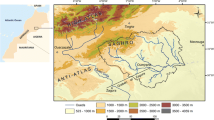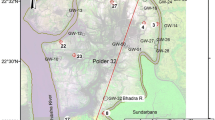Abstract
Relationship of hydro-uranium anomalies (2-649 ppb) vis-à-vis underlying uranium ore body has been attempted based on seventy nine water samples collected from the exploratory boreholes on the northern periphery of Srisailam sub basin, Nalgonda district, A.P. Water table is hosted in the granitoid aquifer which underlies the cover rocks of Srisailam Formation. TDS (total dissolved salt) range from 123 to 1088 ppm (x− = 329 ppm) and analyzed >500 ppm in eight samples. Water samples show a strong positive correlation of TDS with Cl− (r=0.90), Na+ (r=0.82), Mg (r=0.80) and a moderate positive correlation with Sr (r=0.48) and Ca (r=0.70). Low value (<0.4) of Normalised Magnesium (NMg) indicates that host rock aquifer has not undergone chloritisation. Accumulate contour plan of uranium ore body shows NW-SE trend and coincides with the hydro-uranium contour. Correlation sections of ore body display true as well as false hydro-uranium anomalies in N-S and E-W profiles. Hydro-uranium anomalies owe their origin to uranium cations, dissolved from the mineralized horizon in to groundwater. Hydro-geochemical orientation survey carried out at Chitrial plateau may be applied regionally in the Srisailam sub basin as an effective tool to explore the concealed unconformity type uranium mineralization below Srisailam Formation.
Similar content being viewed by others
References
Cuney, M.L. (2005) World-class unconformity-related uranium deposits: key factors for their genesis. In: Mao Jingwen & Bierlein FP (eds), Mineral Deposit Research: Meeting the Global Challenge. Proceedings of the Eighth Biennial SGA Meeting 2005, Beijing, August 18–21.
Ferguson, J., Chappell, B.W. and Goleby, A.B. (1980) Granitoids in the Pine Creek Geosyncline. In: J. Ferguson and A.B. Goleby (Eds.), Uranium in the Pine Creek Geosyncline. IAEA, Vienna, pp.73–90.
Gibbs, R.J. (1970) Mechanism Controlling World’s Water Chemistry. Science, v.170, pp.1088–1090.
Giblin, A.M. and Snelling, A.A. (1983). Application of hydrogeochemistry to uranium exploration in the Pine Creek Geosyncline, Northern Territory, Australia. Jour. Geochemical Exploration, v.19, pp.33–55.
Jefferson, C., Gandhi, S., Ramakers, P., Delaney, G., Thomas, D., Cutts, C. and Olson, R. (2005) Unconformity-associated uranium deposits: 2005 Convention CD-ROM, Prospectors and Developers Association of Canada, Toronto.
Jeyagopal, A.V., Prakhar Kumar and Sinha, R.M. (1996) Uranium mineralization in the Palnad sub-basin, Cuddapah Basin, Andhra Pradesh, India. Curr. Sci., v..71, no.12, p.25.
Hoeve, J., Sibbald, T.I.I., Ramaekers, P. and Lewry, J.F. (1980) Athabasca Basin unconformity-type uranium deposits: A special class of sandstone type deposits. In: Uranium in the Pine Creek Geosyncline. IAEA, Vienna, pp.575–594.
Nagaraja Rao, B.K., Rajurkar, S.T., Ramalingaswamy, G. and Ravindrababu, B. (1987) Stratigraphy, structure and evolution of the Cuddapah Basin. Jour. Geol. Soc. India, v.7, pp.33–50.
Singh, R.V., Sinha, R.M., Bisht, B.S. and Banerjee, D.C. (2002) Hydrogeochemical exploration for unconformity related uranium mineralization: examples from palnad sub-basin, Cuddapah Basin, Andhra Pradesh, India, Jour. Geol. Explo., v.76, pp.71–92.
Sinha, R.M., Shrivastava, V.K., Sarma, G.V.G. and Parthasarathy, T.N. (1995) Geological favourability for unconformity related uranium deposits in northern parts of the Cuddapah Basin: evidences from Lambapur uranium occurrence, Andhra Pradesh, India. Explor. Res. Atomic Minerals, v.8, pp.111–126.
Sinha, R.M. (2004) Application of hydrogeochemical survey in search for concealed uranium mineralisation — Some Indian examples. Jour. Applied Geochem., v.6(2), pp.133–146.
Steven A.M., Earle and Garth L. Drever (1983) Hydrogeochemical exploration for uranium within the Athabasca Basin, Northern Saskatchewan. Jour. Geochem. Explo., v.19, pp.57–73.
Vasudeva Rao, M., Nagabhushana, J.C. and Jeyagopal, A.V. (1989) Uranium mineralization in the Middle Proterozic Carbonate rock of the Cuddapah Supergroup, Southern Peninsular India. Expl. & Res. for Atomic Minerals, v.2, pp.29–38.
Author information
Authors and Affiliations
Corresponding author
Rights and permissions
About this article
Cite this article
Verma, M.B., Dandele, P.S., Nagendra Babu, G. et al. Hydrouranium anomalies as an effective tool in exploration of concealed unconformity related U-deposit in Srisailam sub-basin, Andhra Pradesh — Case study from Chitrial area. J Geol Soc India 78, 468–476 (2011). https://doi.org/10.1007/s12594-011-0108-2
Received:
Accepted:
Published:
Issue Date:
DOI: https://doi.org/10.1007/s12594-011-0108-2




